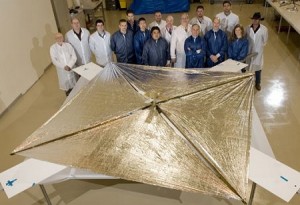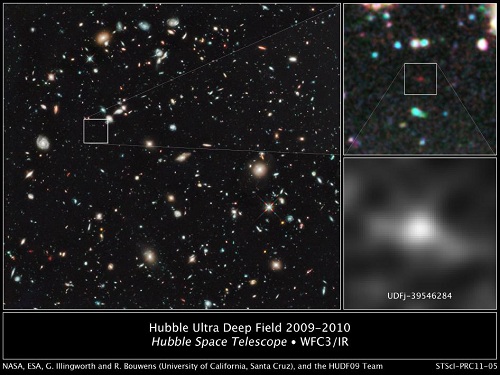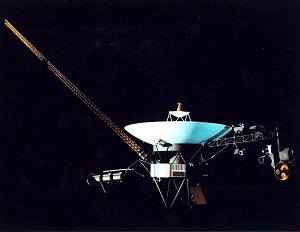Centauri Dreams
Imagining and Planning Interstellar Exploration
Good News from Both Sail Missions
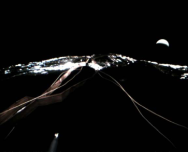
Good fortune continues to smile on Japan’s IKAROS solar sail. First of all, we can point to the image at left, a small shot to be sure but an amazing one nonetheless. Emily Lakdawalla explains on the Planetary Society’s blog that IKAROS’ transmitter is not powerful, so that it took a full two weeks to transmit the image from the spacecraft to Earth, and at that, it’s just a thumbnail. But take a look — what you see is the sail itself and, in the background, Venus. Think about it: A solar sail has successfully made an interplanetary crossing.
Yesterday the JAXA controllers behind the IKAROS mission confirmed that its first six months of life have been all but flawless, and the mission has been extended to March of 2012. This includes the deployment of its 20-meter diagonal, 0.0075 milimeter thick polyimide sail — you may remember that was a bit of a nail-biter from here because I was trying to translate tweets in Japanese and follow the incoming imagery, which at one point seemed to show a snarled cable. But that turned out to be a mis-reading, and full sail deployment was subsequently confirmed.
Almost as significant as actual deployment, though, was the success of the attitude control system JAXA built into the sail, which includes liquid crystal devices that can be turned on and off to vary the reflectivity of the sail, and thus creates changes in photon pressure for maneuvering. During the subsequent cruise operations on the way to Venus, IKAROS collected information on space dust and was used for very long baseline interferometry observations of deep sky objects. Up next: A suite of navigational studies, including varying the sail’s angle to the Sun and changing trajectory, maneuvers that will model the sail’s response for future missions.
The success of IKAROS to this point bodes well for the next major Japanese sail attempt, which will involve a sail ten times the size of this one paired with an ion propulsion unit on a mission to Jupiter. Launch is currently planned for 2019 or 2020, and this article in Science notes that there are plans to operate in conjunction with US and European missions to conduct joint observations of the giant planet. IKAROS mission manager Osamu Mori is looking ahead: “In half a year, we accomplished all the mission objectives. Now we’ve set new objectives.”
Tracking NanoSail-D
Meanwhile, NASA’s NanoSail-D is 650 kilometers up, having unfurled its own 10-meter square sail. Unlike IKAROS, NanoSail-D’s mission is much closer to home, according to principal investigator Dean Alhorn (NASA MSFC):
“Our mission is to circle Earth and investigate the possibility of using solar sails as a tool to de-orbit old satellites and space junk,” explains Alhorn. “As the sail orbits our planet, it skims the top of our atmosphere and experiences aerodynamic drag. Eventually, this brings it down.”
Atmospheric drag will indeed return NanoSail-D to Earth, where it will burn up in the atmosphere in 70 to 120 days. What’s ahead are useful observations measuring the effect of sunlight on the sail. It’s possible that atmospheric drag will mask the effect, but just how the orbit decays will help to answer that question. NanoSail-D may be the harbinger for future ‘drag sails’ that de-orbit satellites after their missions are over, a necessity given the amount of orbital debris building up around the Earth. But a successful sail deployment also gives hope to those who believe a robust future lies ahead for solar sailing as a way to move payloads around the inner system.
For those with an interest in seeing NanoSail-D, bear in mind that the sail is quite reflective. If Venus appears to us at an apparent magnitude of -5 at its brightest and the full Moon hits magnitude -13, NanoSail-D should be able to show up at -10, a substantial target when sunlight glints off the sail. A new contest encourages amateur photographers and astronomers to submit photos of the sail to help NASA monitor the condition of the spacecraft. A series of cash prizes are offered, with contest rules and a submission link at the site.
Image: The NanoSail-D team after a deployment test. Credit: NASA/MSFC.
Remember, too, that the NanoSail-D mission dashboard is here, while you can track satellite flybys at the spaceweather.com site. The contest has already begun and will end when the spacecraft re-enters the atmosphere in three months or so. So have some fun with NanoSail-D while it’s up there, and let’s hope that both it and IKAROS are joined soon by another solar sail in the form of the Planetary Society’s LightSail-1. The solar sail era is coming upon us, slowly but surely, and the advantages of leaving propellant behind will one day make these technologies indispensable.

The Most Distant Galaxy Yet?
As we improve our ability to look back to the early universe, the changes we see in galaxies at this period compared to later eras are striking. A new study, using data from the Hubble Space Telescope’s Wide Field Planetary Camera 3 has been gathering infrared imagery back to a period as early as 480 million years after the Big Bang. What stands out in this work is the rate of star formation. In the period between 480 million to 650 million years after the Big Bang, the rate of star birth increased ten times. Garth Illingworth (UC-Santa Cruz) calls the result “…an astonishing increase in such a short period, just 1 percent of the current age of the universe.”
Moreover, the number of galaxies themselves showed a marked change. Says Illingworth:
“We’re getting back very close to the first galaxies, which we think formed around 200 to 300 million years after the Big Bang… Our previous searches had found 47 galaxies at somewhat later times when the universe was about 650 million years old. However, we could only find one galaxy candidate just 170 million years earlier. The universe was changing very quickly in a short amount of time.”
Among the galaxies studied is a candidate that appears to be the most distant galaxy ever observed, some 13.2 billion light years from Earth. The newly found galaxy has a redshift value (z) of 10.3, which places it just 480 million years after the birth of the universe. Remember that these redshifts are not Doppler shifts, which would be caused by the physical motion of the galaxies as they moved away from us in space. Rather, they are ‘cosmological’ redshifts. The photons being emitted from the galaxies are stretched as they travel through an expanding spacetime.
Image: The farthest and one of the very earliest galaxies ever seen in the universe appears as a faint red blob in this ultra-deep-field exposure taken with NASA’s Hubble Space Telescope. This is the deepest infrared image taken of the universe. Based on the object’s color, astronomers believe it is 13.2 billion light-years away. (Credit: NASA, ESA, G. Illingworth (University of California, Santa Cruz), R. Bouwens (University of California, Santa Cruz, and Leiden University), and the HUDF09 Team).
The concept goes back to the Dutch astronomer Willem de Sitter, who went to work on Einstein’s general theory of relativity not long after it was published and discovered that a stretching of space itself would cause light from more distant objects to appear redder than light from nearby objects. Hubble’s later observations could then be explained using de Sitter’s concept as indications that space and the photons in it are being stretched as the universe expands. David Weintraub tackles the subject in depth in his new book How Old Is the Universe (Princeton University Press, 2011:
Space that is empty of matter does not and never did exist. The distances between galaxies, galaxies being dense pockets of matter in an otherwise rarefied universe, are increasing with time but the galaxies themselves are not speeding through space. On the grandest scale (that is, ignoring small local motions that all galaxies have as they interact with nearby galaxies), galaxies are fixed in their locations in space. They do not move through space. Yet the distances between galaxies grow rapidly because the fabric of space in between the galaxies is continually being stretched, taffy-like, with the galaxies patiently riding along at fixed locations in the taffy.
Sorry for the digression, but I finished Weintraub’s book a few weeks back and have been paging back through it now and then with these concepts in mind. I’ll review the book soon. In any case, I hope the digression helps to put the new work in context, and points out how significant finding a galaxy with a z value of 10.3 is. The finding and the analysis of galaxies at slightly lower redshifts allows us to start building up a population of very early galaxies, and that should offer useful information re how galaxies form, particularly because the number of galaxies in this period increases so rapidly.
All of this work involves data originally collected from the Hubble Ultra Deep Field (a small region in the constellation Fornax) which were gathered during two four-day stretches in 2009 and 2010, focusing Hubble’s WFC3 infrared camera on a tiny part of the HUDF for a total exposure time of 87 hours. What also emerges from this work is that galaxies this faint and small (the Milky Way is 100 times larger) will need the resources of the James Webb Space Telescope for follow-up study beyond redshift 10.

NASA Teleconference This Afternoon
Be aware of a NASA teleconference coming up at 1 PM EST (1800 UTC) today to discuss interesting Hubble data re the early universe. I’ll be publishing today’s entry on these findings not long after the teleconference starts. You can follow audio of the event here.
Encounters Remembered and Anticipated
After yesterday’s meditation on the Voyager spacecraft and their significance in the larger canvas of space exploration, it’s worth recalling that we have just celebrated Voyager 2’s encounter with Uranus — this month marks the 25th anniversary of the event. If your memories of the encounter are fuzzy, you might recall the other major news driver that January, the explosion of the Space Shuttle Challenger, which drove Uranus results off the front page. The national psyche was riveted by Challenger, and understandably so, but what a shame to see analysis of the Voyager flyby all but lost in the coverage of an event so much closer to home.
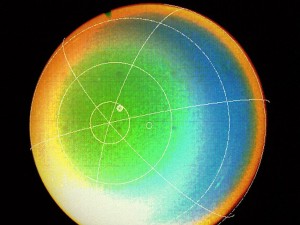
Voyager 2’s closest approach took place on January 24, 1986. I remember it because I was getting ready for a weekend flight training session in Frederick, Maryland and hoping I wouldn’t miss the subsequent release of Voyager imagery and data. In those days, the small company I was flying for did clinics for the Aircraft Owners and Pilots Association, and if memory serves, this was a weekend when the weather cooperated, with relatively high ceilings and no icing issues. I remember working with students on instrument approaches in the West Virginia mountains the day Challenger blew up (the 28th), trying to concentrate on the job at hand instead of speculating about what could have caused the disaster.
Image: A latitude-longitude grid superimposed on this Voyager 2 false color image shows that Uranus’ atmosphere circulates in the same direction as the planet rotates. Credit: NASA/JPL.
I also remember how hard it was to get Voyager news that night on the television. Only much later would I find out how unusual the results had been, especially the discovery that the magnetic north and south poles on the planet weren’t aligned with Uranus’ rotation at all, but were close to the equator. Moreover, the Uranian poles were more or less the same temperature despite the fact that one would be in sunlight for decades while the other was not. Remember, this is a planet with an almost 90-degree axial tilt, probably the result of a collision early in its life with another large body.
Keeping both poles at the same temperature suggests an unusual heat transport mechanism, but so much about Uranus was strange, including tiny Miranda, which had been expected to be cratered and ancient, but turned out to be filled with valleys and ridges and breathtaking cliffs, indicators of tectonic and thermal activity. There was even some speculation that the moon might be a re-aggregation of material following earlier destruction in a massive impact. Voyager also gave us the first imagery of the Uranian rings and their small shepherding moons.
New Horizons Nears Uranian Orbit
All these Uranus memories remind me that New Horizons, our Pluto/Charon mission, will cross the orbit of Uranus on March 18. So how is our other deep system mission going now that the Voyagers are pushing at the boundaries of the heliosphere? The New Horizons team is celebrating the fifth anniversary of launch, which occurred on January 19, 2006 on an afternoon when clouds cleared just in time for the event. That one was a bit frustrating, too — I remember trying to get launch coverage from NASA TV and finding that the local cable company had inserted a replay of a city council meeting from earlier in the week in place of NASA, with no explanation or apology. Coverage on the Net was available but plagued by bandwidth issues.
Even so, the news coming back from various other Net sources was all reassuring, and the flawless launch has been followed by an exceptionally trouble-free cruise thus far. New Horizons has needed fewer trajectory correction maneuvers than had been anticipated, according to this news release from the JHU/APL site. As of this morning at about 1335 UTC, the mission is at 2,969,429,304 kilometers from Earth, with a light delay of 2 hours 45 minutes. The Planetary Society has published a report by Ted Stryk from the New Horizons science team meeting, held last week at NASA Ames, from which we learn that the spacecraft is awakened from hibernation once a year to test its instruments and conduct science.
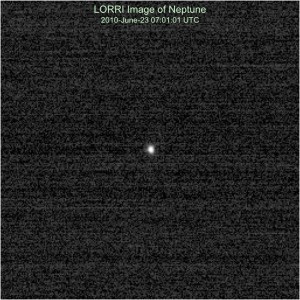
Stryk recounts some of the interesting science that has flowed from this:
Over the past few years, LORRI, the high resolution camera on New Horizons, has been making observations from its unique vantage in the outer solar system. It has obtained light curves of Pluto, Uranus, Neptune, Triton, and Makemake, and the data to construct light curves have been obtained for several other Kuiper belt objects. RALPH and MVIC, other cameras aboard New Horizons, have also been studying Uranus and Neptune. ALICE, which studies ultraviolet light, is making observations of the interplanetary medium, and the fields and particles instruments are now being used even during hibernation, with their data stored for downlink after wakeup. The limiting factor on cruise science is the fact that New Horizons cannot transmit data as fast as it used to because of its increasing distance from the Sun. Presently, the data rate is down to 3 kilobits per second.
Image (above): The New Horizons Long Range Reconnaissance Imager (LORRI) observed Neptune on June 23, 2010 as part of a test of the critical optical navigation Annual Checkout (ACO)-4. In this 100-millisecond exposure, taken when the spacecraft was 23.2 astronomical units (about 2.15 billion miles) from Neptune, the planet appears slightly larger than a star. At the time of this observation, the solar phase angle (the spacecraft-planet-Sun angle) was 34 degrees and the solar elongation angle (planet-spacecraft -Sun angle) was 95 degrees. Only New Horizons can observe Neptune at such large solar phase angles, which can be used to study the light-scattering properties of Neptune’s atmosphere. Credit: NASA/Johns Hopkins University Applied Physics Laboratory/Southwest Research Institute.
We continue to reap the benefit of New Horizons’ flight through the Jupiter system, which provided not only exceptional imagery but useful data on Jupiter’s magnetotail, all of which resulted in six papers on the magnetotail thus far. Science team co-investigator Fran Bagenal says the New Horizons work at Jupiter “provoked a new way of looking at solar wind interaction with the Jovian magnetosphere.” So things have not exactly been quiet during the cruise to the edge of the Solar System, particularly during the Jupiter encounter, and remember that after the Pluto/Charon flyby, we still have interesting possibilities re observing Kuiper Belt objects. Let’s hope the results can be analyzed in an atmosphere less disaster-laden than the Challenger winter of 1986.

Voyager and the Will to Explore
I remember thinking when Voyager 2 flew past Neptune in 1989 that it would be a test case for how long a spacecraft would last. The subject was on my mind because I had been thinking about interstellar probes, and the problem of keeping electronics alive for a century or more even if we did surmount the propulsion problem. The Voyagers weren’t built to test such things, of course, but it’s been fascinating to watch as they just keep racking up the kilometers. As of this morning, Voyager 1 is 17,422,420,736 kilometers from the Earth (16 hours, 8 minutes light time).
Then you start looking at system performance and have to shake your head. As the spacecraft continue their push into interstellar space, only a single instrument on Voyager 1 has broken down. Nine other instruments have been powered down on both craft to save critical power resources, but as this article in the Baltimore Sun pointed out recently, each Voyager has five still-funded experiments and seven that are still delivering data. The article quotes Stamatios “Tom” Krimigis (JHU/APL) as saying “I suspect it’s going to outlast me.”
Deep Space and Human Lifetimes
Krimigis is one of two principal investigators still on the Voyager mission, out of an original eleven, and the only remaining original member of the Voyager instrument team. These days he’s caught up with Cassini work (he’s principal investigator on an APL instrument aboard), but he did find time to report Voyager 1’s findings on the solar wind at the American Geophysical Union meeting in San Francisco. These are major observations, the first time since the beginning of space exploration that we’ve come to a place where the solar wind stops.
But tempering that sense of excitement is the fact that we currently have only one mission following up the Voyagers’ path to the outer system, the New Horizons probe to Pluto/Charon and the Kuiper Belt. The Sun‘s article quotes Norman Ness (University of Delaware) as saying that Voyager was the pinnacle of his career. “There is never going to be a mission in anybody’s lifetime, now living, that is ever going to get these observations in hand. So it’s once in a lifetime.” Stephen Pyne makes much the same point in Voyager: Seeking Newer Worlds in the Third Great Age of Discovery (Viking, 2010), leaving us with a reminder that continued expansion into deep space is by no means a given.
But back to the question of mission length and the reliability of parts. What’s fascinating about the Sun‘s article is that it covers Krimigis’ work on instruments that could measure the flow of charged particles during the mission. Such instruments — low-energy charged particle (LECP) detectors — would report on the flow of ions, electrons and other charged particles from the solar wind, but because they demanded a 360-degree view, they posed a problem. From the article:
…Voyager needed to keep its antenna pointed at the Earth at all times, so the spacecraft itself couldn’t turn. That meant Krimigis’ instrument needed an electric motor and a swivel mechanism that could swing back and forth for more than a decade without seizing up in the cold vacuum of space.
“They said I was crazy,” Krimigis said. To spacecraft designers, moving parts spell trouble.
Krimigis argued there was less mission risk in moving one component, than in turning the whole spacecraft. The solution was offered by a California company called Schaeffer Magnetics. Krimigis’ team tested the contractor’s four-pound motor, ball bearings and dry lubricant.
“We ran it through about a half a million steps [movements], enough to take us to Saturn and then some. And it didn’t fail,” Krimigis recalled.
And yes, you guessed it, after more than 5 million ‘steps,’ the instruments are still working. These days they’re working in a region where solar particles no longer strike Voyager 1 from behind, and it’s been like that for the last six months. Krimigis says the instruments can still detect a particle flow, evidently a mix of solar and interstellar particles, moving in a flow perpendicular to the spacecraft’s direction of travel, so it appears we’re still not in true interstellar space, but in a place where, as the scientist puts it, “…the solar wind is kind of sloshing around.”
With the spacecraft now expected to keep transmitting for twenty or so more years, we’ll surely see both Voyagers reach into true interstellar space before their power runs out. Then the loss of energy will take its toll. Somewhere around 2015 Voyager 1 will shut down its data tape recorder, just as Voyager 2 shuts down its gyros. As instruments go quiet, all power will be shunted to interstellar wind measurements and communications with the distant Earth. As we reach 2020, the few instruments still able to operate by sharing power will be unable to be supported. We’ll be left with nothing more than a tracking signal that can last perhaps as late as 2025.
The Decision to Explore
It’s hard to think of these splendid machines shutting down, but ponder that if they make 2025, that will mark almost fifty years of continuous operation for some of their components. The thinking here is that if a vehicle can survive such a lengthy journey without being specifically designed to do so, an interstellar probe built from the ground up to last a century or more should be well within our capabilities. No, it’s not systems reliability that’s the Achilles’ heel of interstellar flight. As always, it’s propulsion, and that other great imponderable: The will to explore.
Only the latter will determine whether the Voyagers really were a single, magnificent gesture or part of a continuum along which our species will move. Is Ness right that we won’t see the Voyagers’ like in our lifetimes? Here again I think of Stephen Pyne’s book, and an assumption that infuses his coverage:
Voyager’s visionaries looked to the future. They thought of the Voyagers as instruments, and assumed their journey was simply another incremental moment in what would prove to be an irresistible expansion over the solar system and beyond. The Grand Tour mission would be followed by more and better missions. They could not know that Voyager would culminate a golden age, that its trek would be unique, that it might require a distinctive narrative. Even the most culturally sensitive such as Sagan looked only outward and forward. They imagined, in Emerson’s phrasing, a continued succession of ‘new lands, new men, new ideas.’
Norm Haynes, who was project manager for the Voyager 2 Neptune encounter, said of the event, “It wasn’t a once in a lifetime experience. It was a one-time experience.” Is he right? Is Pyne right that the Voyagers marked not the beginning but the end of a great era of exploration? These are troubling thoughts to those of us who believe that expanding into the Solar System and beyond is crucial not only for the good of the human spirit but for the very survival of our species. But long-term projects are guided by the decisions and the will of those who conceive and nurture them. The question now is whether we have the will to keep pushing, Voyager style, into the dark.

A Cometary Return
Another comet looms, but first, some sail news. If everything went well, NanoSail-D opened its sail at 0255 UTC this morning, and indeed @NanoSailD in a tweet not long after the supposed deployment time said the satellite had sent data confirming the sail was open. We’re now waiting for ground-based tracking to confirm the fact, so patience is in order. Meanwhile, reports from hams tracking the satellite’s beacon on 437.270 MHz are still welcome and should be sent to the NanoSail-D2 Mission Dashboard. Henk Hamoen (PA3GUO) in the Netherlands put together the video below showing his tracking of NanoSail-D. The sail should be visible once deployed — check Heavens Above for visible pass predictions (thanks to @MarkGStacey for the tip).
Later: This from an MSFC news release:
Friday, Jan. 21 at 10 a.m. EST, engineers at NASA’s Marshall Space Flight Center in Huntsville, Ala., confirmed that the NanoSail-D nanosatellite deployed its 100-square-foot polymer sail in low-Earth orbit and is operating as planned. Actual deployment occurred on Jan. 20 at 10 p.m. EST and was confirmed today with beacon packets data received from NanoSail-D and additional ground-based satellite tracking assets. In addition, the NanoSail-D orbital parameter data set shows an appropriate change which is consistent with sail deployment.
Back to Tempel 1
But today’s other mission news involves a more distant object, and a cometary rendezvous scheduled for Valentine’s Day. The target is a familiar one, comet Tempel 1, to which the Deep Impact spacecraft delivered an impactor back in July of 2005. This time the spacecraft is the same Stardust vehicle that collected cometary particles from comet Wild 2 in 2004, along with samples of interstellar dust. After the dust collection (and subsequent return of samples to Earth in 2006 via a capsule that ejected from the spacecraft), controllers changed the craft’s trajectory. The mission was subsequently re-named Stardust-NExT and Tempel 1 became the target.
Tim Larson is project manager for the mission at JPL, and he’s understandably proud of the spacecraft’s performance in its different roles:
“You could say our spacecraft is a seasoned veteran of cometary campaigns. It’s been half-way to Jupiter, executed picture-perfect flybys of an asteroid and a comet, collected cometary material for return to Earth, then headed back out into the void again, where we asked it to go head-to-head with a second comet nucleus.”
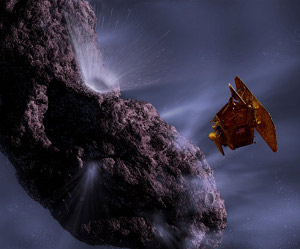
It’s an interesting comet, too, given that this is the first time we’ll be able to look at the changes to a comet’s surface that have accumulated after an orbit around the Sun. Data on the material being emitted into the coma, its distribution and composition, should offer us useful information about Jupiter-family comets and their growth. The latter are short-period comets with periods of less than twenty years and aphelia that reach as far as the vicinity of Jupiter’s orbit. Jupiter family comets tend to have longer active lifetimes than long period comets, many of them surviving up to 1000 revolutions before the volatiles in their nuclei evaporate away.
Image: An artist’s impression of Tempel 1 and the Deep Impact spacecraft in 2005. Deep Impact sent a 370-kg impactor into the comet in July of that year, but the resulting dust obscured its view of the newly formed crater. Credit: NASA/JPL/UMD/Pat Rawlings.
It will be fascinating to see whether the high-resolution images that should come from this encounter will include the crater created by the Deep Impact collision, which was obscured by dust after the 2005 impact. 72 images are scheduled in all, with raw imagery sent back to Earth for processing on February 15. The current plan is for the images to be made available within hours. Stardust-NExT, having made eight flight path correction maneuvers and one Earth gravity assist since 2007, will fly past Tempel 1 at a distance of roughly 200 kilometers.
With twelve years of space travel (and four circuits of the Sun since the beginning of the Tempel 1 mission alone), Stardust-NExT has logged almost six billion kilometers since its 1999 launch. We’ve gotten our money out of this one, and Tempel 1 should be its last destination, for the spacecraft is nearly out of fuel. The spacecraft is already imaging Tempel 1 to create the data needed to update predictions of the comet’s trajectory. In just 24 days, we’ll be able to see the comet up close (again), and will be able to measure the dust properties of a second comet with the same instrument used on the Wild 2 dust measurements. As we’ve seen before, re-purposing a spacecraft gives us a low-cost way to stretch our technology in the form of a useful extended mission.

